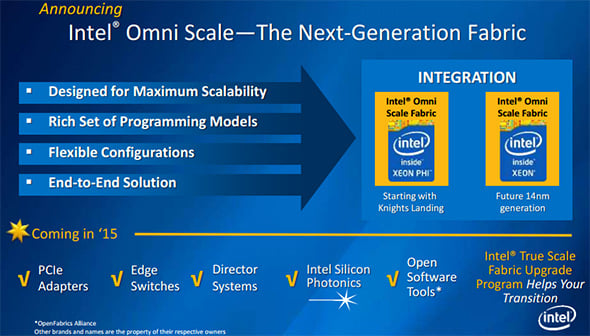Intel And Micron Empower New Xeon Phi Processor With Hybrid Memory Cube Technology
Intel today made a splash at the International Supercomputing Conference in Leipzig, Germany by revealing new details about its next-generation Xeon Phi processor technology. You may better recognize Xeon Phi by its codename, Knights Landing, which we covered in some detail earlier this year. No matter what you call it, this represents a significant leap in High Performance Computing (HPC) that will deliver up to three times the performance of previous generations while consuming less power.
A big part of the reason for this is the construction of a new high-speed interconnect technology called Intel Omni Scale Fabric, which Intel has been a bit cagey about, though reportedly it is comprised of silicon photonics interfaces as well as IP acquired from Cray and QLogic. This will be integrated into the next generation of Xeon Phi processors as well as future general-purpose Xeon chips.
"Intel is re-architecting the fundamental building block of HPC systems by integrating the Intel Omni Scale Fabric into Knights Landing, marking a significant inflection and milestone for the HPC industry," said Charles Wuischpard, vice president and general manager of Workstations and HPC at Intel. "Knights Landing will be the first true many-core processor to address today's memory and I/O performance challenges. It will allow programmers to leverage existing code and standard programming models to achieve significant performance gains on a wide set of applications. Its platform design, programming model and balanced performance makes it the first viable step towards exascale."
A big part of the reason for this is the construction of a new high-speed interconnect technology called Intel Omni Scale Fabric, which Intel has been a bit cagey about, though reportedly it is comprised of silicon photonics interfaces as well as IP acquired from Cray and QLogic. This will be integrated into the next generation of Xeon Phi processors as well as future general-purpose Xeon chips.
"Intel is re-architecting the fundamental building block of HPC systems by integrating the Intel Omni Scale Fabric into Knights Landing, marking a significant inflection and milestone for the HPC industry," said Charles Wuischpard, vice president and general manager of Workstations and HPC at Intel. "Knights Landing will be the first true many-core processor to address today's memory and I/O performance challenges. It will allow programmers to leverage existing code and standard programming models to achieve significant performance gains on a wide set of applications. Its platform design, programming model and balanced performance makes it the first viable step towards exascale."
At launch, more than 60 HPC-enhanced Silvermont-based cores will connect with up to 16GB of on-package, high-bandwidth memory designed in partnership with Micron, which leverages the fundamental DRAM and stacking technologies found in Micron's Hybrid Memory Cube (HMC).
Intel says this solution will deliver five times better bandwidth compared to DDR4 memory, five times better energy efficiency, and three times more density than current GDDR-based memory. When combined with Intel Omni Scale, the new memory solution will allow Knights Landing to be installed as an independent compute building block, thereby allowing customers to save space and energy by cutting back on the number of components.
Knights Landing will be available as a standalone processor mounted directly on the motherboard socket, as well as come in PCIe-based card options for those who need a quick and easy upgrade path -- there is application compatibility between today's True Scale Fabric and the upcoming Omni Scale Fabric. However, there are tangible benefits to the socketed options, including the reduction of programming complexities and bandwidth bottlenecks of data transfer over PCIe.
Look for Knights Landing processors to being powering HPC systems in the second half of 2015.
Intel says this solution will deliver five times better bandwidth compared to DDR4 memory, five times better energy efficiency, and three times more density than current GDDR-based memory. When combined with Intel Omni Scale, the new memory solution will allow Knights Landing to be installed as an independent compute building block, thereby allowing customers to save space and energy by cutting back on the number of components.
Knights Landing will be available as a standalone processor mounted directly on the motherboard socket, as well as come in PCIe-based card options for those who need a quick and easy upgrade path -- there is application compatibility between today's True Scale Fabric and the upcoming Omni Scale Fabric. However, there are tangible benefits to the socketed options, including the reduction of programming complexities and bandwidth bottlenecks of data transfer over PCIe.
Look for Knights Landing processors to being powering HPC systems in the second half of 2015.



